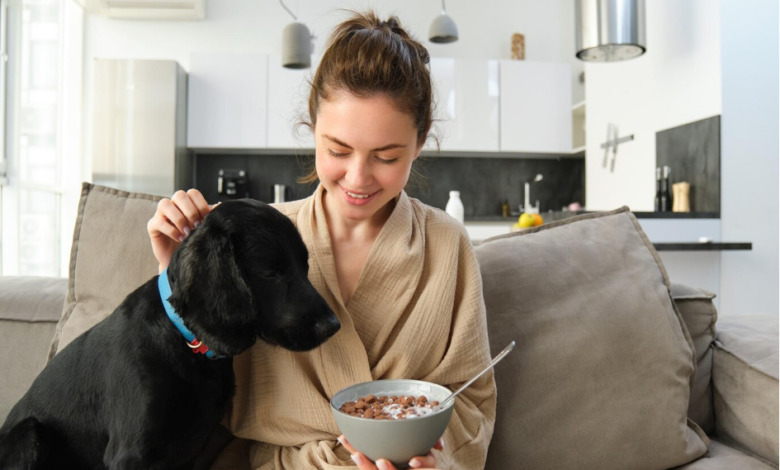Wet Dog Food for Picky Eaters: Tips That Work

Understanding Your Dog’s Picky Eating Habits
It can be super frustrating when your dog turns their nose up at food, especially when you’re trying to make sure they get all the nutrients they need. Before you start experimenting with different dog wet food options or searching for the closest pet market near me, it’s worth taking a step back to figure out why your dog is being so picky. It might be more than just a preference for certain flavors.
Identifying Underlying Health Issues
Sometimes, a sudden change in appetite can signal a health problem. If your dog suddenly becomes a picky eater, it’s a good idea to rule out any medical causes first. Dental issues, for example, can make it painful for them to chew, leading them to avoid food. Other potential culprits include gastrointestinal problems, infections, or even something as simple as nausea. A vet visit can help identify and address any underlying health concerns that might be affecting your dog’s appetite.
Recognizing Behavioral Patterns
Believe it or not, picky eating can sometimes be a learned behavior. If you’ve consistently offered your dog a variety of foods in an attempt to find something they like, they might have learned that holding out will eventually get them something even better. It’s like a kid at the dinner table who refuses to eat their vegetables, knowing they’ll get dessert if they wait long enough. Consistency is key here. Avoid constantly switching foods, and try to stick to a regular feeding schedule.
Considering Environmental Factors
Your dog’s environment can also play a role in their eating habits. Stress, anxiety, or even changes in their routine can affect their appetite. Think about any recent changes in your household, such as a new pet, a move, or even a change in your work schedule. These things can all contribute to a dog’s pickiness. Make sure your dog has a quiet, comfortable place to eat, away from distractions and potential stressors.
Creating a calm and predictable environment can often make a big difference in your dog’s willingness to eat. Sometimes, all it takes is a little bit of patience and understanding to get your furry friend back on track.
Selecting the Right Wet Dog Food
Choosing the right dog wet food can feel overwhelming, especially with so many options at the pet market near me. It’s not just about grabbing the first can you see; it’s about understanding what your dog needs and what makes a particular food a good fit. Let’s break down the key things to consider.
Prioritizing High-Quality Ingredients
The ingredient list is your best friend. Look for dog wet food where real meat, poultry, or fish is listed as the first ingredient. Avoid foods packed with fillers like corn, wheat, and soy, as these offer little nutritional value and can sometimes cause digestive issues. You want a food that’s rich in protein, healthy fats, and essential vitamins and minerals. Think of it like this: you wouldn’t want to eat junk food all the time, and neither should your dog.
Exploring Different Protein Sources
Not all proteins are created equal. Some dogs do well with chicken, while others might have sensitivities and need something like salmon, lamb, or even novel proteins like venison or duck. If your dog has a history of allergies or digestive problems, it’s worth experimenting with different protein sources to see what works best. Don’t be afraid to try something new! You might be surprised at what your dog enjoys and tolerates well.
Choosing Appropriate Textures
Texture matters, especially for picky eaters. Some dogs prefer pate-style dog wet food, which is smooth and easy to eat. Others might like chunkier options with gravy or shredded varieties. It really depends on your dog’s individual preferences. If your dog is hesitant to try a new food, try offering a small amount of different textures to see which one they gravitate towards. It’s all about finding what appeals to their palate.
Finding the right dog wet food is a process of trial and error. What works for one dog might not work for another. Be patient, pay attention to your dog’s reactions, and don’t be afraid to switch things up until you find a winner.
Effective Transition Strategies
Switching your picky eater to a new dog wet food can be tricky. It’s not just about plopping down a new bowl of food and hoping for the best. A smooth transition is key to avoiding tummy troubles and food refusal. Think of it like introducing a new member to the family – it takes time and patience. You might be tempted to just switch cold turkey, especially if you’re excited about a new premium dog food you found at the pet market near me, but trust me, a gradual approach is almost always better.
Gradual Introduction Techniques
This is the golden rule: slow and steady wins the race. Don’t shock your dog’s system with a sudden change. Start by mixing a small amount of the new dog wet food with their current food. Over several days, gradually increase the amount of new food while decreasing the old. Here’s a sample schedule:
| Day | New Food | Old Food |
| 1-2 | 25% | 75% |
| 3-4 | 50% | 50% |
| 5-6 | 75% | 25% |
| 7 | 100% | 0% |
Of course, adjust this based on your dog’s reaction. If they seem to be having digestive issues, slow down the process.
Mixing with Current Food
Mixing is more than just dumping two foods together. Pay attention to the consistency. If the new dog wet food is very different from their current food, you might need to mash them together a bit to make it more appealing. Also, consider the temperature. If one food is cold and the other is room temperature, that can be off-putting. Make sure they’re roughly the same temperature. A well-mixed bowl can make all the difference.
Warming the dog wet food
Warming up the dog wet food slightly can really boost its aroma and make it more enticing, especially for picky eaters. It’s like how a warm cookie smells way better than a cold one! Just be careful not to overheat it. You don’t want to burn your dog’s mouth. A few seconds in the microwave is usually enough. Always test the temperature with your finger before serving. Here are a few things to keep in mind:
- Never microwave the food in its metal can.
- Use a microwave-safe bowl.
- Stir the food well after warming to distribute the heat evenly.
Warming the food can be a game-changer, but it’s not a magic bullet. If your dog still refuses to eat, don’t force it. Try other strategies, like adding toppers or changing the feeding environment. Sometimes, it’s just about finding what works best for your individual dog.
Enhancing Palatability of Dog Wet Food
So, your dog is turning up their nose at even the tastiest-looking dog wet food? Don’t worry, it happens! Sometimes, you just need to get a little creative to make mealtime more appealing. It’s like when you’re trying to get a kid to eat their veggies – a little extra flavor can go a long way. Let’s explore some simple tricks to make that dog wet food irresistible.
Adding Flavorful Toppers
Think of toppers as the sprinkles on an ice cream sundae for your dog’s dinner. A small addition can make a big difference. Here are some ideas:
- Cooked Chicken or Beef: Small, shredded pieces of plain cooked meat are almost always a hit. Make sure it’s unseasoned!
- Plain Yogurt or Cottage Cheese: A dollop of plain, unsweetened yogurt or cottage cheese can add a creamy texture and a boost of calcium.
- Small Amount of Canned Fish: Sardines or tuna (in water, not oil) are packed with omega-3 fatty acids and have a strong, appealing smell.
Incorporating Broths and Gravies
Broths and gravies can add moisture and flavor to dry dog wet food, making it more enticing. Look for low-sodium options specifically made for dogs. You can even make your own!
- Low-Sodium Chicken Broth: Warm it up slightly for an extra aromatic boost.
- Bone Broth: Bone broth is packed with nutrients and has a savory flavor that many dogs love.
- Dog-Specific Gravies: There are several commercial gravies available at the pet market near me that are designed to be added to dog food.
Serving at Optimal Temperature
Temperature can play a big role in how appealing food smells and tastes to your dog. Slightly warming the dog wet food can release its aromas and make it more enticing.
- Microwave: Heat the food for a few seconds (5-10 seconds) until it’s just slightly warm, not hot. Always test the temperature before serving.
- Warm Water Bath: Place the sealed container of dog wet food in a bowl of warm water for a few minutes.
Warming the food can be especially helpful for older dogs or those with a decreased sense of smell. It’s all about making the food as appealing as possible to encourage them to eat.
Creating a Positive Feeding Environment
Okay, so you’ve got the right dog wet food, you’re transitioning slowly, and you’re even adding toppers. But your picky eater still turns up their nose? It might be the where and when that’s the problem. Dogs are creatures of habit, and a stressful or inconsistent feeding environment can totally kill their appetite. Let’s look at how to make mealtime a more pleasant experience for your furry friend.
Establishing a Consistent Schedule
Dogs thrive on routine. Seriously, they do. A regular feeding schedule helps regulate their digestive system and can reduce anxiety around mealtime. Think about it: if you knew exactly when your next meal was coming, you’d probably feel less stressed about food too.
- Feed your dog at the same time(s) every day.
- Stick to the schedule even on weekends (as much as possible).
- If you need to change the schedule, do it gradually.
Minimizing Distractions During Meals
Imagine trying to enjoy a nice dinner while someone is vacuuming or the TV is blaring. Not exactly relaxing, right? The same goes for dogs. Distractions can make them anxious and less likely to eat. Find a quiet spot where your dog can focus on their food.
- Turn off the TV or radio.
- Keep kids and other pets away during mealtime.
- Choose a location away from high-traffic areas.
Using Appropriate Feeding Bowls
Believe it or not, the type of bowl you use can impact your dog’s eating habits. Some dogs don’t like their whiskers touching the sides of the bowl, while others might be sensitive to certain materials.
- Consider a shallow, wide bowl for dogs with short snouts.
- Use a ceramic or stainless steel bowl, as plastic can harbor bacteria.
- Elevated bowls can be helpful for larger dogs or those with mobility issues.
Creating a calm and predictable feeding environment can make a huge difference for picky eaters. It’s not just about the food itself, but also about the overall experience. By addressing these environmental factors, you can help your dog feel more comfortable and confident at mealtime, which can lead to a healthier appetite.
If you’re still struggling to find the right dog wet food, check out your local pet market near me. They often have a wide selection and knowledgeable staff who can offer personalized recommendations.
Troubleshooting Common Picky Eater Issues
Addressing Food Aversion
Sometimes, your dog’s pickiness isn’t just fussiness; it’s a full-blown aversion. Maybe they had a bad experience with a certain food, or they associate it with something unpleasant, like medicine. Figuring out the root cause is key.
- Try offering the dog wet food in a different bowl.
- Change the location where you feed your dog.
- Make sure there are no stressors around during meal times.
It’s important to be patient and understanding. Never force your dog to eat, as this can worsen the aversion. Instead, focus on creating positive associations with food.
Managing Portion Sizes
Are you overfeeding your dog? It’s an easy mistake to make, especially with those pleading eyes! Overly large portions can lead to a lack of appetite. Try reducing the amount you offer at each meal. You might be surprised at how much less they actually need. Check the feeding guidelines on your dog wet food packaging and adjust accordingly. Also, consider the treats you give throughout the day. Those calories add up!
Dealing with Refusal to Eat
Okay, so your dog is flat-out refusing to eat. What do you do? First, make sure it’s not a medical issue. If they’re otherwise acting normal, try these tips:
- Remove the food after 15-20 minutes if they haven’t touched it. Don’t leave it out all day.
- Offer the food again at the next scheduled mealtime.
- Consider a different brand or flavor of dog wet food. You can find a pet market near me to explore options.
| Day | Food Offered (oz) | Food Consumed (oz) | Notes |
| Monday | 4 | 0 | Refused entirely |
| Tuesday | 3 | 1 | Ate a small amount after adding broth |
| Wednesday | 3 | 2.5 | Improved appetite with new flavor |
When to Consult a Veterinarian
It’s easy to get caught up in trying different dog wet food options and tricks to get your picky eater to eat. But sometimes, picky eating is a sign of something more serious. Knowing when to involve your vet is super important for your dog’s health.
Recognizing Persistent Appetite Loss
Okay, so your dog skips a meal now and then. That happens. But if they’re consistently turning their nose up at food, even their favorite dog wet food, for more than a day or two, it’s time to pay attention. Persistent appetite loss can indicate an underlying health problem that needs professional attention. It’s not just about being picky anymore. Keep a log of when your dog eats and how much they consume. This information will be helpful for your vet.
Identifying Signs of Illness
Sometimes, a picky appetite is just one piece of the puzzle. Look for other signs that your dog might be sick. These can include:
- Lethargy (being unusually tired)
- Vomiting or diarrhea
- Changes in drinking or urination
- Coughing or sneezing
- Weight loss
If you notice any of these symptoms along with a decreased appetite, don’t wait. Call your vet. It’s better to be safe than sorry. You might think it’s just a phase, but it could be something serious that needs immediate care. Plus, your local pet market near me might have some bland food options that are easier on a sick dog’s stomach, but always check with your vet first.
Seeking Nutritional Guidance
Even if your dog seems healthy otherwise, a vet can offer valuable insights into their nutritional needs. They can help you determine if your dog’s picky eating is causing any deficiencies and recommend a balanced diet. They can also rule out any medical reasons for the pickiness and suggest strategies tailored to your dog’s specific needs. Sometimes, it’s not about finding the tastiest dog wet food, but about ensuring they’re getting the right nutrients.
It’s easy to fall into the trap of constantly switching foods, hoping to find the magic formula that will make your picky eater happy. However, this can actually make the problem worse. A vet can help you develop a consistent and healthy feeding plan that addresses your dog’s individual needs and preferences.
Wrapping It Up
So, there you have it. Getting a picky dog to eat can feel like a real uphill battle sometimes, right? But with a little patience and trying out different things, you can totally find what works for your furry friend. Remember, it’s all about making mealtime a good experience for them. Don’t give up if the first thing you try doesn’t work. Keep experimenting with different wet foods, textures, and even how you serve it. Your dog will thank you for it, and you’ll both be happier at mealtime. Good luck!




